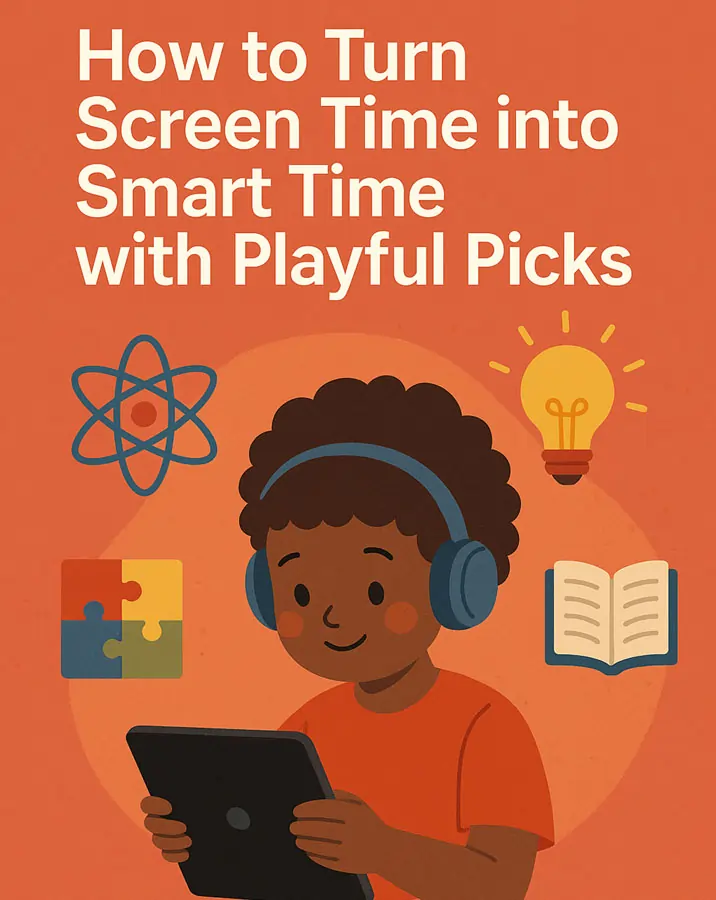How to Turn Screen Time into Smart Time with Playful Picks?
If you’re thinking screen time is just a distraction or a necessary evil, you have got to change your approach. It doesn’t have to be mindless, and you don’t have to ban it altogether. The real issue isn’t the screen. But the way it is used.
Screen time can be smarter if you give it the right direction.
Yes. Your children don’t need more rules. They only need a better direction, which makes their time interactive enough to support language, build memory, and strengthen real-world thinking.
This guide walks you through five playful ways to make screens work for your child’s growth—not against it. You’ll also uncover common mistakes that keep learning stuck and how to avoid them.
Why is passive screen time a missed opportunity for learning?
Passive screen time means a child watches content without interacting. Think of a toddler silently staring at cartoons or a teen endlessly scrolling through videos. Their brain absorbs visuals but doesn’t process deeply or respond. That’s where the learning gap begins.
Now, let’s put that into perspective. According to speech-language pathologists from Expressable, passive screen time lacks back-and-forth interaction. That interaction—called “conversational turns”—is key to developing vocabulary and communication skills. Research cited by Expressable shows that toddlers who watch more videos may speak 6–8 fewer words for each additional hour of passive viewing. That’s not a small difference—it’s a measurable setback in early language development.
In fact, one study shared by the Canadian Paediatric Society found that toddlers exposed to over two hours of passive TV per day were six times more likely to experience language delays. This risk increases when the content is not educational or when caregivers aren’t present to explain what’s happening.
But that’s not all. Passive screen use also suppresses creativity. Kids are receivers instead of creators. They don’t ask questions, tell stories, or try new things. Over time, this limits not just language growth, but also emotional and cognitive development. As shown in a 2017 review (PMC5823000), too much solitary screen exposure correlates with poorer executive function, lower memory retention, and reduced attention spans.
On the flip side, children thrive in active environments. They learn best through human interaction—responding, imitating, asking, and hearing responses. If a screen replaces that, even for an hour, that hour is lost for brain-building activities like storytelling, pretend play, or simple conversations.
The American Academy of Pediatrics suggests screen time should be co-viewed and interactive. For example, talking about characters, pausing to ask questions, or relating what’s happening on screen to real-life experiences.
So, the takeaway is: it’s not the screen that’s the problem, it’s the silence around it.
5 playful picks for turning screen time into smart time
Now, let us walk you through 5 interactive methods to engage your children in a way that turns their screen time into smart time for learning and growth.
Use drawing and animation tools to support storytelling and visual thinking.
Some children think more clearly in pictures than in words. For that reason, screens that offer creative tools—like drawing, animation, and narration—can support real storytelling, not just free play.
Start with a blank scene. Let the child place a character, shape, or object. As the image begins to form, ask a few gentle questions. For example, “Who is this?” or “What’s happening here?” Responses like these often reveal the beginning of a story.
From there, you should help the child build a sequence. You may ponder what came first and then ask what happens next. See, you are not asking for full sentences. But you are helping connect events in order. So, both logic and verbal planning are strengthened.
At this point, you should consider adding one small layer, such as movement or sound. A bouncing ball or a recorded line of dialogue often helps the child understand timing, emotion, and cause and effect. You’ll see how such features deepen both memory and motivation.
The children should stay focused on the meaning throughout the activity. Because the value isn’t in how well the image looks. It’s in how clearly the child can explain what they created. For instance, a house becomes more than a drawing when the child says who lives there, or why it has no door.
So, ultimately, art will become a structured way for children to express, plan, and think. All that’s needed for screen time to be turned into smart time.
Encourage children to record their voice or retell stories to improve expressive language.
Children often know more than they can say, but they need space to practice speaking out loud. A screen that captures their voice gives them a tool to shape that practice into something real. Expression becomes clearer when thoughts get spoken, not just kept inside.
You can start by inviting the child to record a short description of something they made, watched, or imagined. Just a few sentences. No pressure. The point isn’t polish—it’s ownership. The moment they hear their voices playing back, they become the listener too. And that changes how they think about what they say.
Now ask a question. Something simple, like “Did it sound the way you meant it?” or “Is there something you’d like to add?” Instead of correcting, guide the child toward revision. Speaking again, but more clearly this time, builds fluency one step at a time.
Some children enjoy adding details. Others prefer retelling the same idea from a new angle. Both are useful. Retelling builds structure. Shifting perspective builds flexibility. Either way, the language starts to stretch.
Leave space for pauses. Don’t rush the next sentence. Let the child finish a thought fully before prompting the next. That pause helps ideas settle—and makes room for expression that’s more confident and complete.
So, it’s clear that screens that invite voice recording help children take language into their own hands, not just by speaking, but by hearing, adjusting, and trying again. That’s where real communication starts to grow.
Create a randomized activity wheel to promote variety and structured autonomy.
Children often repeat the same screen habits unless something interrupts the pattern. So, a simple activity wheel can add that interruption—with—structure, not pressure. It is very likely to offer a way to keep the valuable screen without turning into a routine loop.
You should start by listing 6–8 different types of tasks. Keep them varied: one for movement, one for storytelling, one for solving something, one for drawing, one for listening, and one for making. Each task should be short, clear, and open enough for the child to make it their own.
You should use a reliable online tool that allows children to spin the wheel with ease. Once the child spins it, let them see what comes up and choose how they want to do it. If the wheel lands on “make something,” they might draw or build. If it lands on “move,” they might copy a video or create a new action. It’s all about encouraging children to make choices within the frame you set.
You should stay nearby to offer light guidance. Ask, “What will you use for this?” or “How will you start?”. Remember that you won’t be controlling the task. You’ll only help the child think before jumping in. This kind of structure supports focus. The child knows what’s expected, but still feels free. Each spin invites a small shift in thinking. That shift matters. It keeps the mind active, not passive.
It should be clear that what makes this smart time isn’t solely the wheel. But in fact, it is the way the wheel creates a rhythm: one decision, one task, one clear end. All that gives the child space to enjoy the screen and step away from it without resistance.
Introduce digital clue-solving tasks to strengthen logic and working memory.
Clue-solving tasks activate reasoning. Each step demands attention, observation, and memory. As the child follows clues, compares details, or tracks hidden patterns, logical thinking becomes more structured.
You can begin with a short digital puzzle. Choose something that asks the child to notice positions, match visual elements, or find sequences. The idea is to hold small parts in mind while working toward a result. That’s how working memory gets exercised.
As the child interacts with the task, stay nearby. Ask focused questions. “What do you see that looks similar?” or “Have you seen that symbol before?” These prompts guide thinking without giving answers. They also help the child slow down and reflect.
Some activities may take a few attempts. That’s expected. Each failed try gives the brain a reason to adjust. Encourage one more try, not by offering solutions, but by pointing back to earlier steps the child took.
After the task ends, invite a quick explanation. “How did you figure that part out?” That one question helps the child recall the steps and strengthens logical order.
Clue-based tasks teach children how to observe carefully, store information briefly, and apply it with purpose. They also teach persistence. Each small breakthrough adds to the child’s confidence in their own reasoning process.
Co-view screen content with children to build comprehension and conversation skills.
You can turn screen time into smart time—but only if you join in. See, when children watch alone, they simply absorb images. But when you sit beside them, everything changes. Suddenly, you will notice that are not merely watching—they’re thinking, asking, and learning with you.
You should start with small questions throughout this playful activity. For example, ask, “What do you think will happen next?” or “Why did that character do that?” . You’ll see your child will begin to reflect, connect ideas, and build stronger language and thinking skills. Even a short chat can boost comprehension more than hours of passive viewing.
Most importantly, your presence adds meaning. Children learn more when someone responds, explains, or just listens. So next time the screen turns on, stay close. Use that moment—not just to watch—but to connect. That’s how you turn screen time into something smarter.
What mistakes prevent screen time from being productive?
- Passive screen time offers no depth. So, sit with the child, talk during the video, and thoroughly guide their attention to key moments.
- Fun without purpose teaches nothing. So, you should choose content that builds thinking, empathy, or real-world knowledge.
- No questions lead to shallow understanding. You must ask what they noticed. Let them explain what surprised or confused them.
- Replacing real talk with screens creates distance. Therefore, watch together and use the story to start conversations.
- Unlimited use tires the mind. Set a clear start and end as well as add breaks to protect focus and energy.
- No real-life link makes the story fade. Relate scenes to family routines, school events, or simple games.
- A quick stop ends the learning too soon. Let the child retell the story, draw a scene, or act it out.
- Labels like “educational” can mislead. It is suggested to check the app or video yourself. So you can make sure it meets your values and goals.
Bottom Line
Screen time becomes smart time and works best with your presence and purpose as a teacher or parent. You must ask questions, spark ideas, and connect the dots to your child’s real life for ultimate interactivity.


